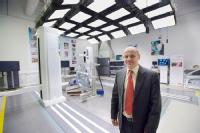WMG News - Latest news from WMG
Car component quality testing technology helps hip surgeons ensure prostheses bind to bones
Hip surgeons are making significant advances in designing hip replacement components using additive manufacturing (3D printing) but have been struggling to devise easy methods of testing the designs they have created without using destructive testing techniques. Now researchers in WMG at the University of Warwick have devised a way of examining and ensuring the quality of those designs without destructive testing using scanning techniques normally used to examine new component designs for high-end automotive manufacturing.
Successful surgical reconstruction or replacement of a joint (arthroplasty) requires integration of the prosthetic implant with the bone to replace the damaged joint. Surgeons therefore seek to use Bone-mimetic biomaterials for implants as their mechanical properties and porous structure can be designed to allow bone ingrowth and help fix the implant.
Those materials can also be assembled to a high precision by 3D printing but surgeons still want to be sure of the absolute quality of the manufacturing process and they need a very high degree of quality assurance before they are content to use such parts in healthcare. All the best ways of conducting such tests are destructive with obvious limitations.
Elvio Gramignano, Global Strategic Marketing Director for Corin Ltd, a leader in orthopaedic innovation, said:
“We were delighted that the WMG researcher team were able to use their X-ray Computed Tomography (CT) equipment, that they have been using to research and test components for the automotive industry, to help provide us with the very fine detail needed to quality test hip replacement components without destroying any part of those components.”
The WMG research is detailed in a paper entitled “Computed tomography metrological examination of additive manufactured acetabular hip prosthesis cups” in the journal Additive Manufacturing Volume 22, Pages 146-152 - click here to read.
The researchers tested this approach by examining a prototype artificial acetabular cup (the cup-shaped socket of the hip joint) made of the material Ti6Al4V. The technology produced a scan of fine 2D slices made up of a collection of 3D pixels, called “voxels” at a resolution of 43 microns (micrometres). Each of these voxels had a particular associated grey tone that showed what the scan had revealed of the atomic density of the material at that precise point. Air has the lowest density and showed as black while materials with higher density are shown in a lighter grey colours. The 3D data can be analysed further to provide dimensional information, volumetric analysis and other measures.
The material’s non-uniform lattice appears as a series of pores and struts which, if correctly optimised, provides a scaffold to enable bone ingrowth into the material and give the best implant fixation and WMG’s scanning technology was able give a precise validation that the pores and struts were optimised.
Professor Mark Williams, from the Centre for Imaging, Metrology, and Additive Technology at WMG,University of Warwick, who led the research said:
“We were delighted to be able to test this method on an innovative hip prosthesis cup prototype. We have shown that this non-destructive, non-contact examination method can provide very detailed information on the interconnectivity of the porous structure, the standard deviation of the size of the pores and struts, the local thickness of the lattice structure in its size and spatial distribution. In particular, this leads to much easier identification of weak regions that could inhibit a successful bond with the bone.”
The full research team on the paper were: Mark A Williams, Nadia Kourra, Jason M Warnett, Alex Attridge, from WMG at the University of Warwick; Greg Dibling, James McLoughlin from Corin Ltd., Corinium Centre, Cirencester; Sarah Muirhead-Allwood from the London Hip Unit; and Richard King from University Hospitals Coventry and Warwickshire NHS Trust.
